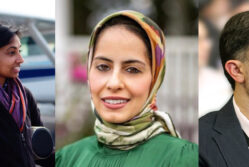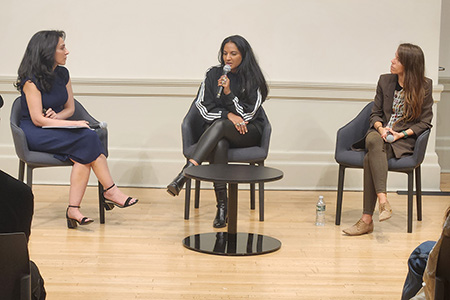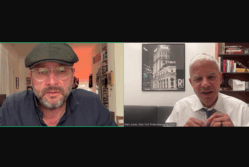Archive Event Highlight

How I Did It: Filmmakers Discuss ‘The Night Doctrine’ After Screening
by Chad Bouchard
Freelance journalist Lynzy Billing traveled to Afghanistan at the beginning of 2019 without a clear reporting plan – she was just looking for answers to questions about what had happened to her mother and sister, who were killed during a night raid nearly three decades ago. That story led her on four-year journey in which she uncovered CIA-backed night raids that killed hundreds of Afghan civilians with no accountability.
During a discussion on Oct. 5 that followed a screening of her animated film on the subject, The Night Doctrine, Billing told OPC Vice President Azmat Khan, the director of the Simon and June Li Center for Global Journalism at Columbia University, that her investigation began to grow while she was exploring Rodat, a rural district in the middle of Nangarhar province. Residents recommended that she speak to a woman named Mahzala about the fate of her two sons, who had been shot and killed in a raid only three months before.
“She didn’t have anyone to talk to, to go to, to find answers as to what had happened. So I told her I’d go to provincial officials on her behalf,” Billing said. After returning to Kabul, she said she put everything else on hold, “and [Mahzala] became this proper driving force behind looking into this story. I was like ‘this is mad. Her two sons had been killed, no one was giving her answers, no one really cares. So that just shifted everything.”
The OPC and Li Center co-hosted the screening and discussion with Billing and filmmaker Almudena Toral, which was part of the OPC program series “How I Did It” that convenes journalists, producers and editors to discuss exceptional work.
Before the film project began, Billing’s investigation first resulted in a story for ProPublica, titled “The Night Raids,” which documented U.S. operations in rural areas and took careful counts of people killed in the raids. She checked her findings with witnesses, local hospitals and a forensic pathologist she recruited to help. Billing visited the sites of more than 30 night raids and conducted more than 350 interviews with current and former Afghan and U.S. government officials, Afghan and U.S. defense and security officials and former CIA intelligence officers.
Billing started her work without any outside funding, and after a few months pitched it to The New York Times, which declined the story. Then, she pitched it to ProPublica, which took on the project and allowed her to take her reporting deeper. The story, which focused on one of four CIA-backed Zero Units, won several awards including the OPC’s Ed Cunningham Award and the Mike Berger Award from Columbia Journalism School.
Toral said her film collaboration with Billing started at ProPublica in 2020, when Tracy Weber, ProPublica managing editor, introduced them. Weber thought Billing’s evidence video would make a good basis for a short video piece.
“Let me tell you, Lynzy’s work was impressive, honestly,” Toral said. “She documented hundreds of raids by herself, in the middle of Afghanistan. It was kind of completely insane,” and included an extensive database that Billing and Toral combed through to find a particularly detailed raid to cover.
Khan asked Toral what led them to the decision to animate the film. Toral said Billing had started filming supplemental footage for a piece in 2021, and had already been discussing a hybrid production with some animated elements.
“But when the U.S. pulled out of Afghanistan, obviously everything was upside down. Then it was very clear that we needed to switch more to animation, partially to protect the sources,” she said.
What had originally been an idea for a three- to five-minute video expanded to 17 minutes, all animated by their “genius” colleague, Mauricio Rodriguez-Pons.
Billing discussed some of the safety considerations for sources for the project, which included interviews with members of the Zero Units.
“For their safety, because they were still inside the units at the time, I would find certain restaurants to meet them in or arrange cars there to meet me. I supplied them with sim cards and different ways, they would put things on the sim cards and hand them over to me and I’d give them a clean one, and swap in and out like that,” she said.
She said she met the forensic pathologist she worked with, Muhammad Rehman Shirzad, while reporting on his laboratory for a previous story. He was eager to work on the project and used a variety of government records to help verify the identities of the dead. Billing said the two worked closely together and postponed or avoided trips if they felt something was off.
“I think it was easier because it was just the two of us, a really small team. We weren’t going in with camera crews and security and a sound guy, we were just going ourselves.”
Click the window below to watch a recording of the discussion that followed the screening.
Related Events




